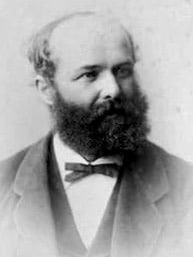Theodor Langhans
Theodor Langhans (1839 – 1915) was a German pathologist.
Langhans is eponymous with Langhans giant cells (1868) after discovering these multinucleated giant cells in the granulomas of tuberculosis. The layer of Langhans (1870) is also eponymously associated with his name, referring to the cytotrophoblast of the placenta which Langhans first described.
He published research works on a wide range of medicine, including the female breast histopathology, the placenta, diseases of the testicle, pathology of goiter, cretinism, and the distribution of glycogen in normal and diseased organs.
Biography
- Born 28 September 1839 in Usingen, Germany
- Studied medicine at the Universities of Heidelburg; Gottingen, under Friedrich Henle (1809–1885); Berlin, under Rudolf Virchow (1821–1902); and Würzburg, under Friedrich von Recklinghausen (1833–1910).
- 1864 – Graduated medical studies from Würzburg, with a thesis on the structure of tendons
- 1867 – Lecturer in pathology at the University of Marburg
- 1872 – Professor of pathological anatomy at the University of Giessen
- 1872-1913 – Chair of pathology at the University of Bern, Switzerland
- Died 22 October 1915 in Bern, Switzerland
Medical Eponyms
Langhans giant cells (1868)
The presence of Langhans giant cells (LGCs) is one of the signatures of systemic granulomatous disorders such as tuberculosis and sarcoidosis. Although originally described in association with tuberculosis, they are found in nearly every form of granulomatous disease, regardless of aetiology.
Langhans described giant cells measuring 0.2-0.3mm while studying fresh tubercles as “already visible with the naked eye as small dots. The position of the nuclei is very unusual and characteristic, namely exclusively at the periphery of the large cells”, and published his findings in his work ‘Über Riesencellen mit wandständigen Kernen in Tuberkeln und die fibröse Form des Tuberkels‘. He thought these cells were merged from other cells.
The eponym Langhans was given to the giant cell with peripheral after a proposal by the German pathologist Carl Weigert (1845–1904) in 1881. “Ich habe mir erlaubt, für diese Art der Zellender Namen ‘Langhans’sche Riesenzellen‘ vorsuschlagen” [I have taken the liberty of proposing the name ‘Langhans giant cells‘ for this type of cell]
Layer of Langhans (1870)
The cytotrophoblast of the placenta.
Langhans was the first to describe this inner layer of the chorionic epithelium.
Major Publications
- Langhans Th. Beiträge zur normalen und pathologischen Anatomie der Arterien. Archiv für pathologische Anatomie und Physiologie und für klinische Medizin, 1866; 36(2): 187–225.
- Langhans Th. Ueber Riesenzellen mit wandständigen Kernen in Tuberkeln und die fibröse Form des Tuberkels. Archiv für pathologische Anatomie und Physiologie und für klinische Medicin. 1868; 42: 382–404 [Langhans giant cells]
- Langhans Th. Primärer Krebs der Trachea und der Bronchien. Archiv für pathologische Anatomie und Physiologie und für klinische Medizin, 1871; 53: 470-484
- Langhans T. Das maligne Lymphosarkom (Pseudoleukämie). Archiv für pathologische Anatomie und Physiologie und für klinische Medicin, 1872; 54: 509–537. [Reed-Sternberg cells of Hodgin’s disease]
- Langhans Th. Über die entzündlichen Veränderungen der Glomeruli und die akute Nephritis. Archiv für pathologische Anatomie und Physiologie und für klinische Medizin, 1885; 99(2): 193–250.
- Langhans Th. Anatomische Beitrage zur Kenntnis der Cretinen. Archiv für pathologische Anatomie und Physiologie und für klinische Medizin, 1897; 149(1): 155-187.
- Langhans Th. Über die epithelialen Formen der malignen Struma. Archiv für pathologische Anatomie und Physiologie und für klinische Medizin, 1907; 189(1): 69-152.
Controversies
Langerhans and Langhans: 2 eponyms which have similar spelling; sound similar when spoken aloud; and were both published in the same journal in the same year – Virchow’s Archive (1868).
- Theodor Langhans (1839–1915) described multinucleate cells characteristic of the systemic granulomatous disorders such as tuberculosis and sarcoidosis (Langhans cell or Langhans giant cell)
- Paul Langerhans (1847-1888) identified the antigen-presenting dendritic cells of the skin (Langerhans cells). These cells may also be found in other tissues, such as lymph nodes, in association with Langerhans cell histiocytosis
The terms are not infrequently mixed up in journal articles, textbooks, and histology reports. Worthy of note here as the eponymous resemblance between the names has led to instances of misdiagnosis and inappropriate treatment with serious clinical consequences [e.g. Pritchard et al 2003]
References
- Weigert C. Zur Theorie der tuberkulösen Riesenzellen. Deutsche medizinische Wochenschrift 1885; 11: 599-602
- Obituary: Theodor Langhans. Centralblatt fur Allgemeine Pathologie und Pathologische Anatomie. 1915
- Escher C. Aktuelles aus der Geschichte. Theodor Langhans (1839-1915) [Contributions from history. Theodor Langhans (1839-1915)]. Pathologe. 1989; 10(6): 373-374.
- Holubar K. J.F.F. Theodor Langhans (1839-1915) zum Gedenken [In memory of J. F. F. Theodor Langhans (1839-1915)]. Wien Klin Wochenschr. 1989; 101(24): 867-870.
- Holubar K, Kopera D. What is an eponym? Exemplified with remarks on Theodor Langhans, Friedrich Merkel, and Paul Langerhans, three contemporary 19th-century pathologists. J Invest Dermatol. 1994; 103(2): 257.
- Pritchard J, Foley P, Wong H. Langerhans and Langhans: what’s misleading in a name? Lancet. 2003; 362(9387): 922.
- Lee TS, Lin YM. Langhans’ giant cell or Langerhans’ giant cell?. Respir Med. 2006;100(9):1666-1667.
- van den Tweel JG. Langhans, Theodor (1839–1915). In: van Krieken J. (eds) Encyclopedia of Pathology. Encyclopedia of Pathology. 2016
- Bibliography. Langhans, Theodor. WorldCat Identities
- Buttner R, Lee J. De-eponymising anatomical terminology. 2020
Doctor in Australia. Keen interest in internal medicine, medical education, and medical history.

